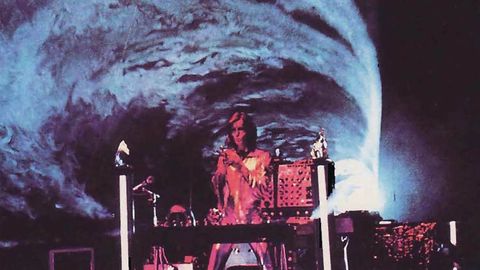Prior to joining Gong in 1973, Tim Blake had been an itinerant hippie roadie with little confidence in his own musical abilities, but his Crystal Machine track on Flying Teapot, a few meditative minutes of synth and delays, was a brief precursor to what would follow – integrated textural playing in that group and, in a few years, onto his full Crystal Machine live show. With a huge customised synth set-up, Blake, clad in a silver spacesuit, was one of the first musicians to use lasers onstage and closed the 1979 Glastonbury Festival in spectacular fashion.
Recorded in 1977, Crystal Machine is all-instrumental except for odd snatches of vocals on Last Ride Of The Boogie Child. Midnight typically rides out on bass pulses topped by melodic lines and an iridescent sheen of rippling, teeming synths. It orbits in a part of the same galaxy as Tangerine Dream and Jean-Michel Jarre – who were using similar technology – but Blake’s own idiosyncratic ideas shine through. Recorded live in Paris, Synthese Intemporal is
a 15 minute epic that begins with birdsong, followed by magisterial synth fanfares and then locks into a sequencer rhythm with agile melodies, including Terry Riley-like keyboard runs, and filtered single notes and blasts of pink noise, like the Doppler effect of a passing craft. Then towards the end, a series of a randomly generated notes drift across the sound field and the sequences start to unravel.
On Blake’s New Jerusalem we are reminded that in the late 70s New Age was a more meaningful idea than its current association with anything insubstantially hippie-dippy. The idea had grown up through the counterculture and referred to a transitional period in the development of humankind. On A Song For A New Age with acoustic and glissando guitar, Blake is looking for enlightenment just as his namesake William was in his poem And Did Those Feet. The speedy cosmic rollercoaster ride of Passage Sur La Cité (Des Revelations) leads us to the lengthy New Jerusalem, where the idealised city is linked with Stonehenge and the pyramids with ‘ley lines glowing all around’.
Blake’s solo career was hampered by contractual problems with Virgin from his time in Gong and after these two albums he joined Hawkwind, who played some of his material including A Song For A New Age in their set.
He became disenchanted with the music business and didn’t achieve the praise and exposure that these inspired excursions into early electronica most definitely deserve. But like beautiful old temples they are still inspiring to behold.


